This article previously appeared in Hotel Business Review on February 23, 2020. HotelExecutive.com retains the copyright.
Since the dawn of social media, hotel owners and operators have challenged their marketing executives and agencies to demonstrate ROI on the investment in engaging with them. And yet social media is outpacing advertising and public relations as a preferred way to reach customers and prospects. As platforms become more sophisticated, along with those responsible organic community management and paid initiatives, it is becoming ever more possible to prove ROI, but you have to have the right approach. This article offers insights and best practices for ensuring that social media is on target and measurable. The ROI question is solvable.
The ROI Question
Social media is a big deal. And it’s an even bigger deal for the hospitality industry. One out of three U.S. travelers reference social media as a main source of travel ideas and inspiration and 52 percent of travelers use social media to plan a trip.
The evolution of social media has changed the way consumers discover travel inspiration and plan trips. According to American photographer Chris Burkard, you’re now less than 10 clicks away from seeing an image on Instagram to purchasing a ticket to go there. That is a powerful statement. So why are so many hotel brands struggling to get results on social media?
In a short decade, social media upended the two longest-standing pillars of marketing communications: advertising and public relations. The misstep made by many brands as they began their foray into social media was misguidedly expecting traditional P.R. and advertising approaches to yield the same results online. Social media requires a specialized approach.
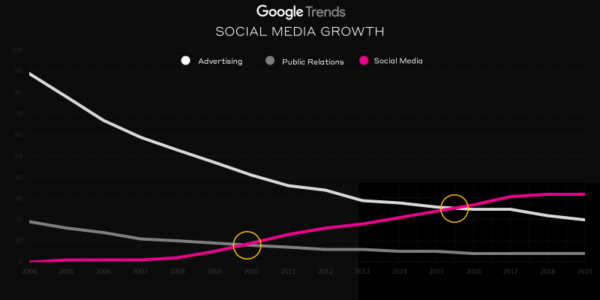
Looking at Google Trend Search Data as a gauge, the impact of social media on the marketing landscape becomes clear. Comparing search terms and topics related to “advertising” and “public relations” versus “social media,” “social media” became bigger than “public relations” in 2009, and bigger than “advertising” in 2015.
Those of us who worked in the industry during this transition experienced this in real time. Seemingly overnight, public relations coordinators became social media managers, and commercials became content. Brands rushed to launch inaugural Facebook pages and publish posts, only to find their content receiving a handful of likes, mainly from employees—and maybe one from Tom from MySpace.
Suddenly, with social media, brands had direct access to their target audiences without restrictions or rigid specifications. But, without a specialized approach and carefully crafted content plan, brands found it difficult to yield results, and the ROI of social media marketing came into question.
This question still lingers. Maybe you’re struggling to understand the value of your social media presence. What are you trying to be, to whom? It’s not your fault. You’re not alone. The good news is the question is solvable.
According to a recent study by Sprout Social, the biggest challenge for social media marketers is “measuring ROI.” In other words, social media teams are still struggling to prove the value of their efforts to skeptical internal stakeholders and leadership teams.
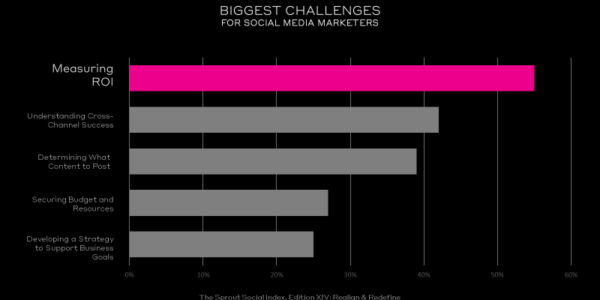
Despite the missing link of measurable ROI, according to eMarketer, CMOs across all industries expect to double their social media marketing budgets over the next five years. We better figure out this whole ROI thing before we get there!
Here’s how to do it.
The Strategic Mindset Shift
Like many strategic conundrums, it goes back to objective setting. In the same report by Sprout Social, the survey found there was very little consensus on how social media drives impact. Is it brand awareness? Engagement? Website traffic? Sales? Social media marketers responded that their biggest goals spanned the entire consumer journey.
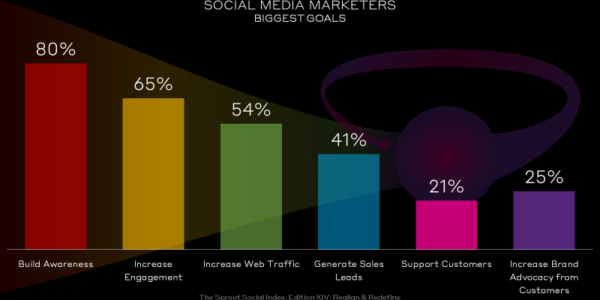
A critical piece of context missing from the report was organic vs. paid social media tactics. Organic social media represents posts that brands publish to their pages, without an advertising budget to support them. Paid social media represents promoted content, using dollars to leverage the ultrapowerful audience targeting and placement tools offered by social platforms such as Facebook and Instagram.
Let’s demystify the objective-setting priority across these tactical paths:
- The purpose of organic (nonpaid) social media is to cultivate an audience of brand advocates through engaging content that lifts brand appeal and supports customer interests and needs.
- The purpose of paid social media is to drive a specific marketing campaign result, such as build awareness, generate sales/leads and drive traffic to a brand website.
The key mindset shift is to accept that organic social media efforts may not yield immediate impact. Instead, organic social media offers the opportunity to humanize your hotel brand. Organic social media is not the tactic to drive brand awareness, considering, for example, on Facebook, hotel brands can only reliably expect to organically reach two to six percent of their followers, let alone anyone outside of that network.
Driving website traffic also presents challenges across platforms, as social media executives are highly incentivized to keep people on their platforms for as long as possible. Driving traffic off the social platform and onto your website is not a priority. Overly promotional content is also a no-no, as people have grown increasingly intolerant of ad content. Being too pushy on a platform like Instagram can put your brand into “Instagram jail,” otherwise known as being blacklisted, where brand channels are relegated for poor engagement. Being blacklisted on social media is a real threat for all brands, and it can take time to dig out.
Marketers can use organic social media tactics to narrow in on the most effective, relevant content for lifting brand appeal. This insight, by identifying the content subjects, narrative elements and formats that work best organically, can be leveraged by the paid social media teams to make overall social media efforts more cost efficient. Running paid social media content that is effectively engaging will reach larger audiences at a lower cost and will make each clickthrough less expensive.
Today, it’s not uncommon for hotel brands to separate these tactics operationally; for instance, the public relations department may lead the organic social work, while a media team runs paid social as a part of a larger advertising budget. While these two tactical paths may have different objectives, there is a tremendous amount of value to merging organic and paid efforts.
For hospitality marketers, it may be tempting to deprioritize organic efforts in favor of short-term gains through a purely paid approach, but there are headwinds afoot. Only 34 percent of people trust ads on any platform. There is also a phenomenon known as “ad-content blindness.” 65 percent of social media users skip video ads, mostly out of habit. Even though social media advertising is targeted and cost-effective compared to traditional methods, the costs are increasing steadily at five times the rate of inflation.
Rising advertising costs reach uncertainty and the risk of lost marketing efficiency make installing the objective of driving brand advocacy through organic social media vitally important. Brand advocacy can come from a variety of audiences—customers, employees, business partners, influencers and, in some cases, noncustomers who are fans of your content but have yet to book a stay or make a purchase.
When highly engaged followers interact with your content, it becomes discoverable to their friends and family, and eventually to look-alike audiences (audiences similar to your target audience). This is how brand advocacy can shift into sustainable growth over time. Advocacy can be measured by engagement, which includes interactions (likes, shares, comments). For video, it can be measured by watch-time. Advocacy can even be evaluated by sentiment shifts monitored through social listening.
For hospitality marketers looking to win on social media, the strategic focus is clear:
- Develop an authentic emotional connection with your target audience via quality organic content.
- Use insights from your organic efforts to optimize content on the paid media side.
- Remain hypervigilant to respond rapidly to customer support needs.
Content Maximization Framework
Another best-practice tool for aiding social media strategy is a framework developed by Google—Hero Hub Hygiene—which is designed to help brands diversify content to build audience loyalty and longevity. As a response to brands chasing viral video concepts on YouTube, the framework was originally intended to steer brands into a more effective methodology for developing and distributing content.
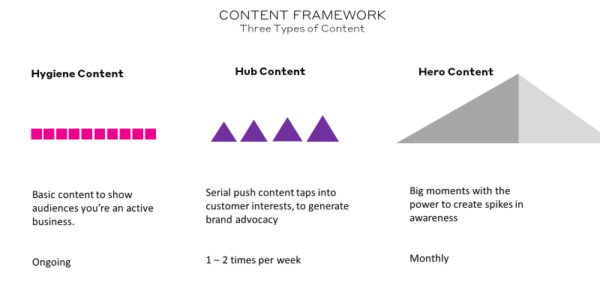
The framework identifies three essential types of content:
Hygiene Content
Basic content posted on an ongoing or daily basis that tells an audience you’re an active company. This is helpful information that may answer key simple questions for people interested in your brand.
For hospitality companies, this may be showcasing amenities, promoting a calendar of events or posting kitchen menu items. It may also be more internal-focused content, like celebrating company culture, new job postings or recent hires.
This is content that most brands already do well but that doesn’t necessarily generate lift.
Hub Content
Hub content is serial push content that taps into customer interests to generate growth and brand lift. Ideally posted one to two times per week, hub content should be relatively inexpensive to produce and thematically tied. The subjects may change, but the composition and format should remain.
In the hospitality space, this may be showcasing the work of professional photographers, integrations with micro-influencers or a reoccurring narrative that connects with your target audience emotionally. Hub content is your chance to develop your own mini-content series.
The key formula for hub content is finding the right blend of messaging that aligns with your audience’s interests, reinforces your brand’s value proposition, and is presented in a content format that works for the social media platform.
Hero Content
Hero content celebrates big PR-worthy moments. These may be significant achievements, notable brand integrations and partnerships, celebrity appearances or significant seasonal launches. Hero moments should carry the branded thematic from hub content but should be amplified with PR efforts for added lift.
When mapping out the content calendar, try to identify a hero moment every month or so and create a content formula for how messaging is launched across channels. Each hero moment may call for a sizzle video, as well as a series for supporting hub posts for pre- and post-buzz.
When content is released using this framework, it will begin to feel like you’re establishing a shared heartbeat with your audience. They begin to expect content and, when hero moments occur, they will celebrate with you as brand advocates with a passion to share your message.
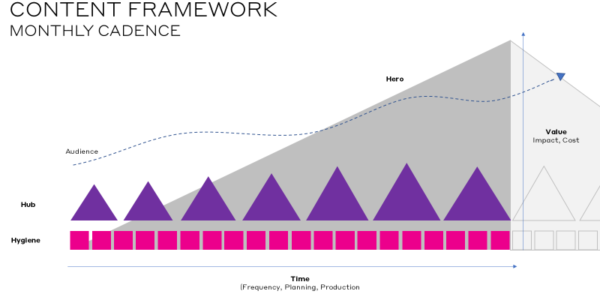
Measuring Return and Final Thoughts
With a maximized social media presence, built with an organically grown following of brand advocates, the advantage of cost-effective, self-sustaining marketing can be realized. Marketing campaigns can become more efficient as time to earn new customers accelerates.
Organic growth is the long-run game with big benefits for those willing to test, measure and learn through a few cycles of content. With a proper strategic framework, marketers can expect to see gains in the first 30 days. The first metric to key in on is engagement rate. First you get the engagement, then you get the reach and then you get new followers.
According to Gary Vaynerchuk, an entrepreneur turned social media star, to be successful on these platforms, marketers need to “stop thinking like an advertiser, and start thinking like a media company.” By using best-practice frameworks, you not only enable space and alignment for creative thinking, you also set your brand up for positive ROI.
